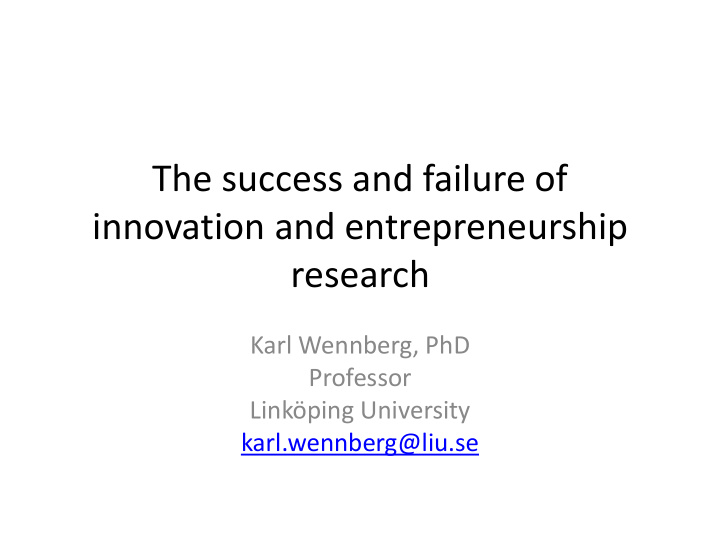



The success and failure of innovation and entrepreneurship research Karl Wennberg, PhD Professor Linköping University karl.wennberg@liu.se
Scholarly tribes in innovation and entrepreneurship research • Economics - Used to ignore entrepreneurship - Last 10-20 years significant progress - Still limited connection between micro (eship) and macro (growth) • Sociology & Psychology - Relationsips, emotions, and networks matter for business (sometimes more than economic factors)) - Entrepreneruship often not of key interest • Management research - too impractical to inform practice? - too immature to inform policy?
We still do not know with certitude if and how innovations lead to Growth. Policies: effective, ineffective, or destructive? When? How?
A stylized ” growth recipe ” 1. Investment in education and training 2. Investment in (the right type of, at the right time) infrastructure 3. Encourage (innovative) entrepreneurship (maybe …)
Innovation more and more rare… … more and more expensive? …and/or organizations or more and more bureacractic?
Innovations (ideas): • non-rival • non-substitutable • non-proprietory Direct effects + spillovers Local universities, research institutions and MNEs crucial!
”Spillovers” broader and of different kinds than implied in simple policy evaluations of specific interventions Exposure to Innovation Exposure to Exposure to Investors • Growing up in a neighborhood or family Entrepreneurship with a high innovation rate leads to a higher patenting, especially for girls. • Increasing exposure to innovation in childhood may have larger impacts on innovation than increasing the financial incentives to innovate. Many "lost Einsteins" – people who would have had highly impactful inventions had they been exposed to innovation. Bell, Chetty, Jaravel, Petkova, & Van Reenen, 2018
Exposure is physical, as is co-location Non-cognitive ability Exposure variables Work Entry Work Entry Entry Work Work Entry Small Workplace 200% Linköping Stockholm Göteborg Malmö 50% Parents were entrepreneurs 20% General ability Residing in Stockholm Ability variables Work Entry Work Work Work Entry Entry Entry 10% General ability Linköping Stockholm Göteborg Malmö 20% Non-cognitive ability Dahlander & Wennberg, 2017
”Spillovers” difficult to identify and difficult to active with direct policy…
Spillovers…sometimes works in unanticipated ways
What can be done?
Our challenge: Objective probabilities in scientific method (Fisher, von Mises, Neyman, Pearson) - Probabilities relevant to the outcome of repeated experiments - Likelihood objectively determined and unaffected by observations - Possible to generate and test hypotheses Problems : Outcome depends on research plan and criteria for reproducibility. - Not reject a null hypothesis does not mean that we with absolute certainty can accept the hypothesis - Rejecting an hypothesis does not mean accepting another - Past point estimates provide little knowledge of the future
US & UK forecasts of governmental spending The Bank of England publishes probabilistic inflation forecasts US Central Bank and Swedish Riksbank publishes point inflation forecasts in estimates Consequences?
UK forecasts of CPI inflation 2,5 2 1,5 Mode 1 Median 0,5 0 Mean 4 3,5 3 2,5 Top 2 Mean 1,5 1 Bottom 0,5 0 1 2 3 4 5 6 7 8 9 10 11 12 13 -0,5 -1
Why point estimates? "Ranges are for cattle. Give me a number." "You can’t give the client a bound. The client needs a point."
If we cannot know the number of balls in an urn when assessing the likelihood of drawing a specific color?
Thanks! Questions / comments? Karl Wennberg, PhD Professor Linköping University karl.wennberg@liu.se
References: Manski, C. F. 2013. Public Policy in an Uncertain World : Harvard University Press. Delmar, F. & Wennberg, K. (2010). Knowledge Intensive Entrepreneurship: The Birth, Growth and Demise of Entrepreneurial Firms. Cheltenham: Edward Elgar. Dimov, D., Berglund, H. & Wennberg, K. 2018. Beyond Bridging Rigor and Relevance: The Three-Body Problem in Entrepreneurship. Forthcoming Journal of Business Venturing Insights, in press. Larsson, J. P., Wennberg, K., Wiklund, J., & Wright, M. 2017. Location choices of graduate entrepreneurs. Research Policy, 46(8): 1490-1504. Sandström, C., Wennberg, K., Wallin, M. & Zherlygina, Y. 2016. Public Policy for Academic Entrepreneurship: A review and critical discussion. In Press, Journal of Technology Transfer. doi:10.1007/s10961-016-9536-x. Kim, P., Wennberg, K. & Crodieu, G. (016. Meso-Level Mechanism of Entrepreneurial Activity in Societies. Academy of Management Perspectives. 30 273-291. Wennberg, K., Wiklund, J., Wright, M. (2011). Academic Entrepreneurship: Performance differences between university spin-offs and corporate spin-offs. Research Policy, 40(8): 1128-1143. Berglund, B., Wennberg, K., Bousfiha, M., Laufer, M. & Mansoori, Y. Experimental Entrepreneurship for Practice and Policy Development. Stockholm: Vinnova. Delmar, F. & Wennberg, K. (2011). Evolutionary Views on Entrepreneurial Processes: Managerial and Policy Implications. Policy Brief, Stockholm: Entreprenörskapsforum. http://papers.ssrn.com/sol3/papers.cfm?abstract_id=2111202 Delmar, F., Wennberg, K. & Hellerstedt, K. (2011). Endogenous growth through knowledge spillovers in entrepreneurship: an empirical test. Strategic Entrepreneurship Journal, 5(3): 199 – 226.
Recommend
More recommend